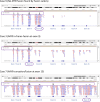MYB/MYBL1-altered gliomas frequently harbor truncations and non-productive fusions in the MYB and MYBL1 genes
- PMID: 39422766
- PMCID: PMC11489301
- DOI: 10.1007/s00401-024-02803-0
MYB/MYBL1-altered gliomas frequently harbor truncations and non-productive fusions in the MYB and MYBL1 genes
Abstract
Astrocytomas that harbor recurrent genomic alterations in MYB or MYBL1 are a group of Pediatric-type diffuse low-grade gliomas that were newly recognized in the 2021 WHO Classification of Tumors of the Central Nervous System. These tumors are described in the WHO classification as harboring fusions in MYB or MYBL1. In this report, we examine 14 consecutive cases in which a MYB or MYBL1 alteration was identified, each with diagnostic confirmation by genome-wide DNA methylation profiling (6 Angiocentric gliomas and 8 Diffuse astrocytomas, MYB- or MYBL1-altered), for their specific genomic alterations in these genes. Using RNA sequencing, we find productive in-frame fusions of the MYB or MYBL1 genes in only 5/14 cases. The remaining 9 cases show genomic alterations that result in truncation of the gene, without evidence of an in-frame fusion partner. Gene expression analysis showed overexpression of the MYB(L1) genes, regardless of the presence of a productive fusion. In addition, QKI, a recognized fusion partner common in angiocentric glioma, was generally up-regulated in these 14 cases, compared to a cohort comprising >1000 CNS tumors of various types, regardless of whether a genomic alteration in QKI was present. Overall, the results show that truncations, in the absence of a productive fusion, of the MYB(L1) genes can likely drive the tumors and have implications for the analysis and diagnosis of Angiocentric glioma and Diffuse astrocytoma, MYB- or MYBL1-altered, especially for cases that are tested on panels designed to focus on fusion detection.
Keywords: MYB; MYBL1; Glioma.
© 2024. This is a U.S. Government work and not under copyright protection in the US; foreign copyright protection may apply.
Conflict of interest statement
All authors have no competing interests to declare.
Ethics approval was received in the form of IRB approval with a waiver of informed consent from the National Institutes of Health. The authors declare that there are no conflicts of interest. The content of the manuscript has not been published or submitted for publication elsewhere.
Figures




References
-
- WHO Classification of Tumours Editorial Board (2021) World Health Organization Classification of tumours of the central nervous system, 5th edn. International Agency for Research on Cancer, Lyon
-
- Ellison DW, Hawkins C, Jones DTW, Onar-Thomas A, Pfister SM, Reifenberger G et al (2019) cIMPACT-NOW update 4: diffuse gliomas characterized by MYB, MYBL1, or FGFR1 alterations or BRAF(V600E) mutation. Acta Neuropathol 137:683–687. 10.1007/s00401-019-01987-0 - PubMed
Publication types
MeSH terms
Substances
LinkOut - more resources
Full Text Sources
Medical

